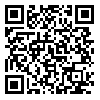BibTeX | RIS | EndNote | Medlars | ProCite | Reference Manager | RefWorks
Send citation to:
URL: http://refahj.uswr.ac.ir/article-1-1842-en.html
Objectives: substance abuse is one of the most important intricacy that threaten the health of different people especially youths and unemployment is also a problem in developing and third world countries that in addition to evil economic consequences is said as a tendency toward crime, guilt and mental diseases. Some studies show a relation between tendency toward substance use and unemployment and all of these researches show that unemployment is a risk factor for substance use. Unemployment persons relate with a lot of people in a day and they have a lot of leisure that spend with others and do activities during a day. The aim of this study was to compare leisure between two groups of Iranian unemployed male youths; drug users and non-users.
Method: This casual comparative study enrolled 200 unemployed young men (20 -30 years) who had referred to job centers of Isfahan. The subjects, selected via cluster random sampling: were divided into two groups: group 1: those who had used substance during the first 6 months after unemployment (n=65) and group two: those who had not used any illicit drugs during this period (n=135). The two groups were compared in terms of leisure. Some instances such as: unemploying for at least 6 months, lack of substance using before unemployment, aware satisfaction in cooperation with research are used as entering criteria and experience of mental diseases and substance use before employment used as exit criteria.
Data collecting means was checklist that was made by researchers. This checklist was prepared after review of reference and qualitative study in unemployed who refer to employment centers of Isfahan and they didn’t use substance after 6 months of unemployment. It was questioned from unemployment in research about period of unemployment and do you used substance until and if they used substance they should answered "when they used for first time". If person had used substance before unemployment, he was thanked and that checklist didn’t give him. Filling of check list was lasted 15 minutes by any sample.
Findings: Statistically there isn't meaningful relation between married situation and education level, age and number of family member in two groups of unemployed who used and not used substance(P<0/05).
Average of numbers of time in each day such as: listening to music, friendly speaking, participated persons in friendly speaking, addicted participated in friendly speaking, friendly speaking with addicted persons were reported more in unemployed who used substance when compared with non used unemployed (P<0/05).
Our logistic regression model showed that substance use could be predicted by mean hours of friendly speaking with addicted a day in last week (OR=2/606,CI: 1/600-4/244 , P<0/001), mean hours of friendly speaking with non addicted a day in last week (OR=1/122,CI: 1/025-1/229 , P=0/013).
Results: in this research numbers of friendly speaking time with addicted and non addicted are predicators of substance use in unemployed male youths. It is suggested that policy makers pay attention to this factors in their macro- programs about fight against opiates.
Received: 2015/08/21 | Accepted: 2015/08/21 | Published: 2015/08/21
| Rights and permissions | |
 |
This work is licensed under a Creative Commons Attribution-NonCommercial 4.0 International License. |





